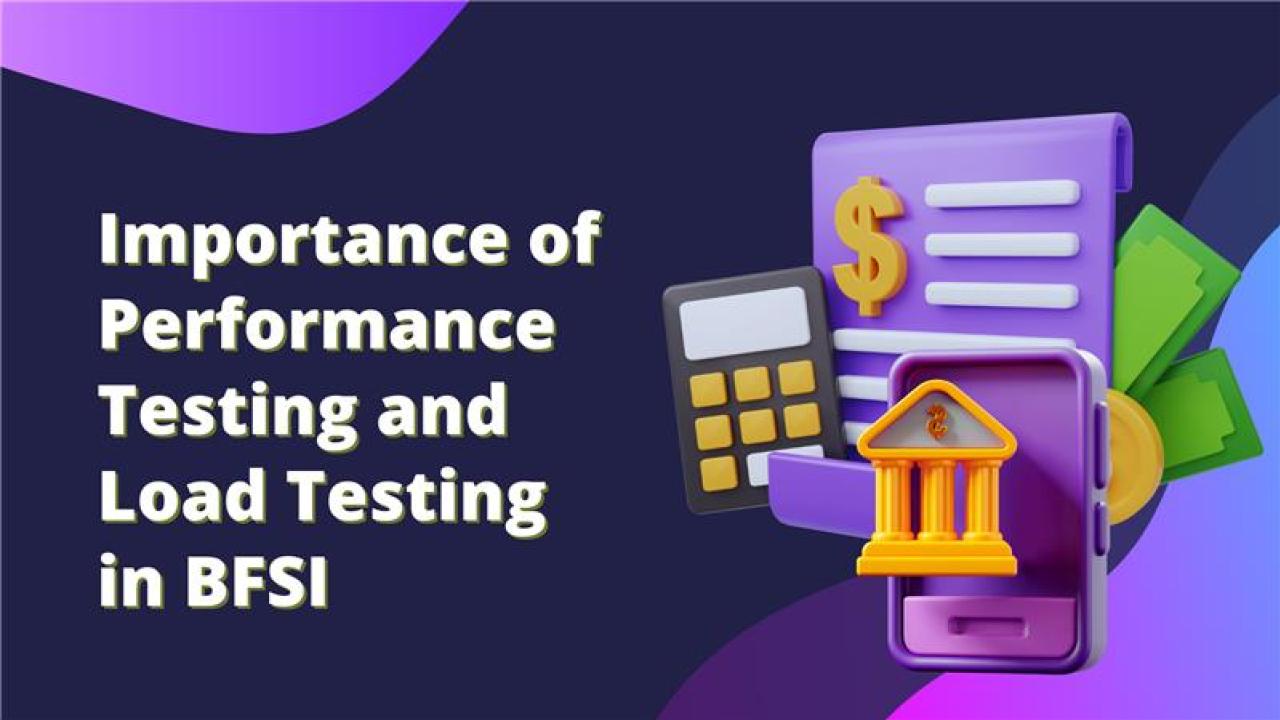The banking and financial services industry (BFSI) faces a quick digital transformation process. Most banking customers demand continuous account access alongside rapid transactions with personalized service profiles. Banking institutions and financial organizations now face substantial pressure because they need to develop strong, secure applications that deliver superior functionality and excellent reliability. The testing procedures of performance testing and load testing serve the industry needs.
Common Performance Failures and Their Impact
Performance issues in BFSI applications fall into three major categories: affecting user interactions, operational effectiveness, and security needs. Identifying and comprehending such system failures and their risks becomes essential to determining which performance testing requirements demand the highest priority to maintain stable operations of vital financial applications.
Impacting User Experience
- Slow Response Times: Applications that operate slowly frustrate users, which often results in customers abandoning their transactions. This negatively affects revenue and customer satisfaction. Minutes of waiting time become an unpleasant experience for customers who wish to view their balances and execute payment processes. When response times are slow, customers feel distrust, and the bank's reputation is damaged.
- System Crashes: System crashes that result in complete breakdowns establish themselves as severe performance indicators through their destructive impact on essential financial operations and their adverse consequences for user trust and regulatory requirements. Account holders face difficulties accessing their information and making payments as well as performing essential banking operations while trying to operate their accounts.
Impacting Operational Efficiency
- Data Corruption: The BFSI applications develop data integrity issues under heavy workloads that result in damaged records, wrong account balances, and unfinished transactions. The corruption of data brings substantial monetary and legal difficulties which force organizations to spend large sums on restorations yet simultaneously destroy their relations with customers.
- Failed Transactions: Finished transactions and exact records often get compromised during system performance failures. Several system problems like network connectivity issues, insufficient resources or database errors lead to these failures. When systems execute transactions unsuccessfully, customers submit complaints together with the additional operational costs and monetary losses.
- Integration Failures: Payment processing and identity verification and credit scoring services as well as other business functions within BFSI applications increasingly depend on integration with third-party partners in modern connected systems. The performance problems with integrated services create disturbances in essential business operations that degrade both system efficiency and end-user experience.
- Poor Scalability: As banks grow and user demand increases, applications must be able to scale seamlessly. Inadequate scalability can lead to performance bottlenecks and system instability, hindering business growth and impacting customer satisfaction.
Impacting Security
- Security Breaches: The combination of performance tests with stress tests demonstrates useful in revealing potential security issues within applications. Denial-of-service attacks along with unauthorized data access frequently happen because attackers find and use performance bottlenecks as entry points. When BFSI applications encounter security breaches the results become destructive because they allow attackers to steal identities while causing financial loss for companies and customers.
Critical Role of Performance and Load Testing in BFSI
The performance and load testing methodologies function as non-functional testing approaches that test system capability while considering various operational scenarios. The proper functionality of an application under targeted workloads is assessed by performance testing services that examine system reactions to high-intensity user activity.
As a part of the BFSI industry, any system performance issues result in major business implications. To achieve QA testing excellence in banking applications, performance testing services are vital for the following reasons:
- Handling High Transaction Volumes: The BFSI sector requires applications capable of processing vast transaction volumes, particularly when peaks occur or when tax season or holiday shopping happen. Performance testing verifies that systems maintain full operational capability when processing the target amount of transactions.
- Ensuring 24/7 Availability: Any moment of system unavailability becomes completely unacceptable for financial institutions. Every customer demands unbroken access to their financial account and service functions. Through load testing, organizations detect weaknesses that may trigger service interruptions.
- Meeting Regulatory Compliance: Business operations in the BFSI sector face strict regulatory demands that mandate strict controls for information protection, transaction management, and reporting requirements. The standards enforced by PCI DSS, GDPR, and others achieve compliance through performance testing.
- Maintaining Customer Satisfaction: Companies in modern competitive markets recognize the importance of delivering exceptional customer experience. Customers leave the platform because of slow load times, application crashes, and security problems. Performance testing enables organizations to provide user experiences that produce smooth outcomes with positive results.
- Supporting Digital Transformation: Banks need performance testing to merge new technologies such as mobile banking, cloud computing, and artificial intelligence with existing systems to protect performance levels.
Best Practices for Performance and Load Testing in BFSI
BFSI applications require performance testing, including load and stress testing, to maintain their reliability and stability. Running these tests by themselves does not achieve sufficient results. The most effective implementation of testing alongside strategic methodology will help maximize both effectiveness and insightful results. Here are some key recommendations:
- Realistic Load Simulation: Performance testing effectiveness originates from developing test scenarios which represent authentic user traffic together with realistic behavioral patterns. The analysis of historical usage data should include trend predictions as well as simulations of peak periods such as holiday shopping seasons and major financial events. By using this approach your testing accurately demonstrates how the application behaves in real-world situations.
- Continuous Testing: Software development lifecycle (SDLC) must include performance testing from start to finish rather than waiting until deployment. The detection process starts early to identify and solve performance problems which minimizes future expensive rework.
- Comprehensive Monitoring: Track key performance indicators (KPIs) throughout the testing process. The testing process must monitor response time and throughput and error rate and resource utilization of CPU and memory and the network. The complete monitoring system reveals essential information about applications which leads testers to identify potential optimization targets.
- Early Issue Detection: Issues detected in the development process's early stages become less expensive to remedy and require simpler solutions. The development cycle should include early testing stages while using diagnosis tools to efficiently detect performance bottlenecks.
- Collaboration: For successful performance testing development teams need to work jointly with testing teams and operation teams. Clear performance communication systems connected to joint goals help teams maintain consensus about measurement targets and repair solutions.
- Invest in the Right Tools: Software performance testing tools LoadRunner, JMeter, Gatling and Blazemeter enable automated testing and analysis and report generation. Testing tools increase both operational effectiveness and efficiency throughout testing procedures.
- Focus on Mobile Performance: The growing popularity of mobile banking requires organizations to make performance testing of mobile apps their top priority. Analyze specific mobile platform aspects which include network conditions as well as device diversity and user behavior patterns.
- Test Third-Party Integrations: BFSI applications in modern times need third-party connections to handle payment processing and identity verification services. A complete testing procedure must examine third-party integrations to stop performance bottlenecks and security vulnerabilities from occurring.
Financial institutions implementing these best practices through performance testing adoption as part of QA will achieve robust and scalable applications with superior customer experiences.
Conclusion
The BFSI sector needs to establish performance testing services, especially load and stress testing, as essential elements in its complete QA testing strategy.
Financial institutions achieve robust, scalable, and secure applications through experienced performance testing partnerships and best practice adherence. This proactive strategy improves customer satisfaction, protects financial value, and regulatory compliance in an environment where digital demands are rising and competition intensifies.



